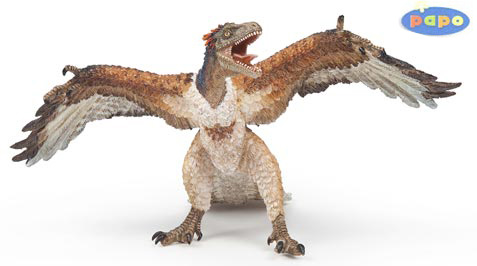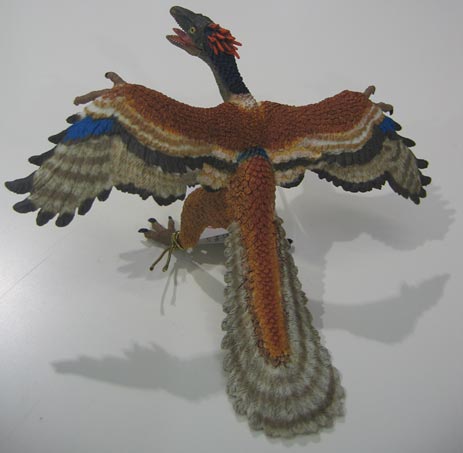New Papo Archaeopteryx Model Reviewed
A Review of the Papo Archaeopteryx Model
Archaeopteryx may not be the oldest known member of the Avian family tree any more, but it remains one of the most famous of all the creatures recorded in the fossil record and the “London” specimen, that marvellous slab of lithographic limestone acquired by Sir Richard Owen for the princely sum of £600.00 GBP, is perhaps one of the most studied fossils in all the world. Fitting then in 2014, Papo of France have added a model of Archaeopteryx to their prehistoric animal model collection.
Papo Archaeopteryx Model
In the Late Jurassic, a large lagoon, dotted with low-lying islands and sheltered from the Tethys Ocean by a substantial reef, covered most of what is now known as southern Germany. The fine grained limestone that was deposited as sediment, coupled with the anaerobic conditions to be found at the bottom of the still, brackish water led to the preservation of the flora and fauna of the area in exquisite detail. A dozen or so specimens of Archaeopteryx have been discovered, including a single feather impression.
Sharing Archaeopteryx’s world were pterosaurs such as Rhamphorynchus and other flying animals such as dragonflies. Stalking amongst the undergrowth was the tiny theropod dinosaur called Compsognathus, one of the smallest dinosaurs, whose fossilised remains have been found in Europe. There were also turtles, king crabs, crocodiles, the remains of ammonites that had been washed up. Thanks to the Solnhofen Lagerstätte, palaeontologists have been able to build up a detailed picture of life in this part of the world during the Late Jurassic.
Feathered Papo Model
For a definition of the term Lagerstätte: Lagerstätte Defined.
The Papo Archaeopteryx Replica
Picture credit: Everything Dinosaur
Papo have combined the features of a reptile and a bird very well in this replica. The model reflects the latest scientific thinking about this transitional fossil, even down to the streaks of darker feathers in the wings and the black tipped feathers that make up the rearward edges of those wings. The three-fingered claws are clearly visible and the paintwork and detail around the reptilian-looking head is excellent. The model measures around twelve and a half centimetres in length and the head is about seven centimetres off the ground. Based on estimations that this “dino-bird” grew to the size of an extant magpie, our experts have estimated that this replica is in approximately 1:5 scale.
Papo Archaeopteryx About to Take to the Air
Picture credit: Everything Dinosaur
The figure rests on its long, fan-like tail, as well as on its dainty toes. The detailing on the underside of the tail is particularly praiseworthy. The design team at Papo have carefully picked out the details of individual feathers, the central shaft or rachis can be made out and even some of the vanes that branch out from this central stem. The colour scheme chosen is innovative and highly decorative and this Archaeopteryx even has a plume of red, display feathers on the back of its head.
To view the range of Papo models available from Everything Dinosaur: Papo Dinosaur and Prehistoric Animal Figures.
All in all a delightful replica of this Late Jurassic flier.



